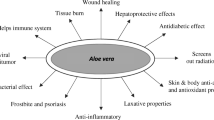Abstract
In this paper the variation in the quantity and quality of the essential oil of Salvia officinalis during its life cycle stages is reported. The oils were obtained by hydrodistillation of air-dried samples. The yield of essential oil (w/w %) in different stages was in the order: floral budding (0.9%) > vegetative (0.7%) > flowering (0.5%) > immature fruit (0.4%) > ripen fruit (0.2%). The essential oils were analyzed by GC and GC-MS. In total, 36, 41, 40, 38, and 41 constituents were identified and quantified in the subsequent stages, respectively. Oxygenated monoterpenes were the main group of compounds in the fruiting set (56.9%), vegetative (48.5%), flowering (47.7%), and floral budding (45.3%) stage. 1,8-cineole as one of the major constituents of all samples was lower in the vegetative stage and gradually increased in subsequent harvesting times to reach a maximum in flowering and then decreased in the fruiting set. In contrast, the globulol content was higher in the first stage and decreased drastically during fruit maturation.
Similar content being viewed by others
References
C. J. Chalchat, A. Michet, and B. Pasquier, Flavour Fragr. J., 13, 68 (1998).
A. O. Tucker, M. J. Maciarello, and B. B. Clebsch, J. Essent. Oil Res., 7, 101 (1995).
D. Rivera, C. Obon, and F. Cano, Econ. Bot, 48, 190 (1994).
V. Mozaffarian, A Dictionary of Iranian Plant Names, Farhang Moaser, Tehran, Iran, 1996.
P. C. Santos-Gomes and M. Fernandes-Ferreira, J. Agric. Food Chem., 49, 2908 (2001).
J. Bruneton, Pharmacognosy, Phytochemistry, Medicinal Plants, Intercept, London, UK, 1999.
J. Hohmann, D. Redei, I. Mathe, and G. Blunden, Biochem. Syst. Ecol., 31, 427 (2003).
M. Wang, Y. Shao, T. C. Huang, G. J. Wei, and C. T. Ho, J. Agric. Food Chem., 46, 2509 (1998).
A. Zargari, Medicinal Plants, University of Tehran Publishing, Tehran, Iran, 1996.
J. A. Duke, Handbook of Medicinal Herbs, CRC Press, LLC, USA, 2001, p. 420.
N. Curtis, Healing Plants, Aventinum Publishing, Prague, Czech Republic, 2000, p. 144.
C. Franz, Volatile Oil Crops: Their Biology, Biochemistry and Production, Hay RKM, Waterman PG Eds., Longman, Harlow, UK, 1993, p. 63.
N. B. Perry, R. E. Anderson, N. J. Brennan, M. H. Douglas, A. J. Heaney, J. A. McGimpsey, and B. M. Smallfield, J. Agric. Food Chem., 47, 2048 (1999).
E. Putievsky, U. Ravid, and D. Sanderovich, J. Essent. Oil Res., 4, 291 (1992).
B. M. Lawrence, Perfum. Flavor., 13, 53 (1988).
B. M. Lawrence, Perfum. Flavor., 23, 47 (1998).
J. A. Pino, M. Estarron, and V. Fuentes, J. Essent. Oil Res., 9, 221 (1997).
M. H. Boelens and H. Boelens, Perfum. Flavor., 22, 19 (1997).
N. B. Perry, A. J. Baxter, N. J. Brennan, J. W. V. Klink, J. A. McGimpsey, M. H. Douglas, and D. Joulain, Flavour Fragr. J., 11, 231 (1996).
G. R. Mallavarapu, R. N. Kulkarni, B. Kuppusamy, R. Laxmi, and R. Srinivasaiyer, J. Agric. Food Chem., 47, 254 (1999)
C. Franz and J. Holzl, Acta Hort., 73, 229 (1978).
E. Bylaite, R. P. Venskutonis, and J. P. Roozen, J. Agric. Food Chem., 46, 3735 (1998).
T. Shibamoto, Retention indices in essential oil analysis, In: P. Sandra and C. Bicchi (Eds.), Capillary Gas Chromatography in Essential Oil Analysis, Huethig Verlag: New York, 1987.
Author information
Authors and Affiliations
Additional information
Published in Khimiya Prirodnykh Soedinenii, No. 1, pp. 16–19, January–February, 2006.
Rights and permissions
About this article
Cite this article
Hossein Mirjalili, M., Salehi, P., Sonboli, A. et al. Essential oil variation of Salvia officinalis aerial parts during its phenological cycle. Chem Nat Compd 42, 19–23 (2006). https://doi.org/10.1007/s10600-006-0027-4
Received:
Issue Date:
DOI: https://doi.org/10.1007/s10600-006-0027-4




